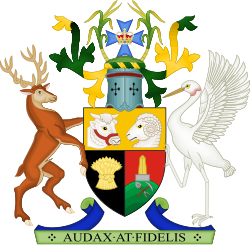Coat of arms of Queensland
| Coat of arms of Queensland | |
|---|---|
 |
|
| Versions | |

State Badge of Queensland
|
|
| Details | |
| Armiger | Elizabeth II in Right of Queensland |
| Adopted | 1893 |
| Crest | Two stalks of sugarcane surround the State Badge, a Maltese Cross with a centred Crown of St. Edward |
| Torse | Green and gold |
| Escutcheon | Wheat sheaf, gold rising from a pile of quartz, the heads of a bull and a ram |
| Supporters | Red deer and brolga |
| Motto |
Audax at Fidelis "Bold but Faithful" |
The coat of arms of Queensland is the oldest in Australia, and was first granted in by Queen Victoria in 1893 through the simplest form of heraldic grants; with the shield of arms, motto, helmet, mantling and crest.
Up to 1892, suggestions were being made as to what the state's coat of arms was to constitute and the pictures below illustrate the four main depictions that were considered.
Below are the four proposed coat of arms submitted to the British College of Arms and from which the first edition of the coat of arms was taken.
These suggestions were accompanied by a letter by the Chief Secretary to the Government Office in London.
Queensland Government Office
Westminster Chambers, Victoria Street
London, SW, 2nd December 1892
Sir,
Referring to your letter of the 13th of May last 92/5479 AG 92/107 concerning the grant of Arms for the Colony of Queensland I have the honour to inform you that your suggestions were submitted to the Heralds College through the Colonial Office and after much consideration the enclosed drawings of the proposed Arms have been furnished by Sir Albert Woods, Garter King of Arms and are forwarded for your approval.
The Honourable Sir SW Griffith KC, MG 2C
Chief Secretary, Brisbane
First example of a proposed coat of arms for Queensland
Second example of a proposed coat of arms for Queensland
Third example of a proposed coat of arms for Queensland
Fourth example of a proposed coat of arms for Queensland
Below is the traditional description, followed by the same description in modern English:-
'Per fesse, the Chief Or, the Base per pale Sable and Gules, in chief a Bull's head couped in profile muzzled, and a merino Ram's head respecting each other proper, the dexter charged with a Garb of the first, and in the sinister Base on a mount a Pile of Quartz, issuant there from a Gold Pyramid, in front of the Mount a Spade surmounted by a Pick saltire-wise all proper'
Translated this means:
'Across the top of the shield a gold panel on which there is a bull's head in profile muzzled, cut off at the neck and a merino ram's head, facing each other, both naturally coloured. In the lower portion of the shield on the left hand side on the black background a golden sheaf of wheat; on the right side on a red background and on a green mound, a golden obelisk standing on a pile of quartz with a crossed pick and shovel in the foreground'
The development of the coat of arms continued during the year and by the end of 1893, the Maltese Cross impaled with the St Edward's Crown had been incorporated, above the shield in between the two stalks of sugar cane. The alterations continued over the years because the crown that is impaled upon the Maltese cross keeps in synchronisation with the monarch in England, due to the switching of crowns. The Imperial State Crown or Tudor Crown, and the St. Edward's Crown are the two coronation crowns that have been used since Charles II's restoration in 1660.
...
Wikipedia
